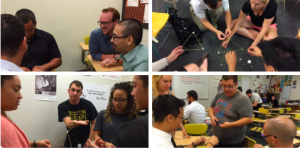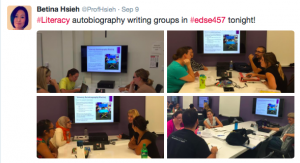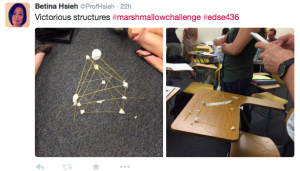Note: I apologize for those who regularly follow my blog that it’s been dormant for the last 5 months. Childbirth and being home with an infant child does that to one’s blogging time, but I’m committed to getting back on blogging with this post
I don’t really have time for collaboration. Just like I don’t have time to blog. Truth be told, with a 4 month old infant, despite the tenure clock ticking, the only thing it really feels like I have time for is my young child, my slightly older child and trying to get any sleep during the day.
But, collaboration, like blogging is something that I need to make time for.
The last 3 days have really highlighted for me the importance of professional collaboration. It began with a writing group in my Secondary Literacy class. Students shared their literacy autobiographies with one another as both a way to model one form of the writing process and a way to build community in the classroom. It was exciting to see these students who were strangers 3 short weeks ago begin to laugh together, make connections and think about the ways that they could address students with experiences similar to that of their group mates (as well as those similar to their own experiences) in their classrooms through attending to literacy. This is the educational community that collaboration builds.
Then, in my Curriculum, Instruction and Management class, we focused on creating a community of learners. In doing so, we participated in several collaborative activities including the marshmallow challenge, where groups worked together to build a free-standing structure from spaghetti, string, tape and a marshmallow, a symbol of how important, but challenging collaboration towards a common goal can be. Students also collaborated around student scenarios and practiced mock parent phone calls as we discussed community inside and outside of our classroom and how important collaboration was on all levels. This is the educational community that collaboration builds.
After my class last night, I had the opportunity to participate in a Connected Learning webinar on “Creating a Culture of Kindness in the Classroom” with my colleagues, Kim Jaxon, Alicia McCauley, and Robbin Jack. I had never met Alicia and Robbin prior to the live webinar, but as we each began talking about how we create classroom community at the elementary, high school, and post-secondary levels, I began to feel the incredible energy of professional collaboration (and conversations) as well as student collaboration and community. It is always a privilege to talk to and work with like-minded people. It reminds me, in an often isolating profession (like teaching, and particularly university teaching, can be) that there are others who share my commitments. This is the educational community that collaboration builds.
Finally, this afternoon, I finished a phone call with my co-instructor, Vicki Braddock, for my Curriculum, Instruction and Classroom Management course. Vicki is a high school principal at the site where our class is held and is co-teaching with me this semester. Like my other co-teaching experience with my university colleague, Huong Tran Nguyen, I have found co-teaching to be an amazing opportunity for myself and for students. In this case, my teacher candidates benefit from Vicki’s 30+ years of educational experience as a teacher and administrator as well as her current perspectives as she leads new initiatives at her site and hires new teachers. And I benefit from Vicki’s perspectives and ideas that help me clarify and sometimes reconceptualize my own ideas as well as adding fresh input to the class. This is the educational community that collaboration builds.
Soon, I’m off to another meeting with Susana Nunez, a current high school teacher (and now university instructor), who is teaching on-site at the other site where I used to teach my Curriculum & Instruction class. We’ll be checking in about how her semester is going and I’ll be supporting her in the next section of the course that we’re both teaching. I’m so excited to be able to work with her on this site-embedded course where students benefit from her on-the-ground perspective and she doesn’t have to start from scratch, using much of the curriculum I designed for the course. This is the educational community that collaboration builds.
As the clock struck 3:30 this afternoon, I thought about my last few days, lamenting the fact that I need to get to a chapter revision with a looming deadline and wondering where the time went. As I pondered, I realized that my life would probably be simpler without collaboration. Collaboration takes a lot of time. Within 24 hours, at least 6 have been spent in active professional collaboration–6 hours that could have been spent working on chapter revisions (or, heck, even 6 hours that could have been spent sleeping!). But, without engaging in active professional collaboration, how could I extol the benefits of educational community and collaboration to my students without being disingenuous? I don’t feel like I could. (Just as I wouldn’t feel right promoting professional reflection when I don’t have time to reflect myself.)
So, yes, collaboration takes time. It can lead to struggle before it leads to success (and sometimes unfortunately, it doesn’t end in success), but it is a process worthy of engagement. Collaborating with likeminded individuals is exhilarating, revitalizing and refreshing. It makes teaching and learning richer. Indeed, this is the educational community that collaboration builds.



